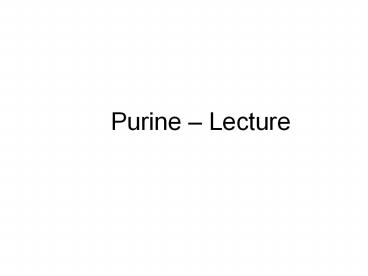Purine - PowerPoint PPT Presentation
1 / 31
Title:
Purine
Description:
Asparate Ribose 5-phosphate PRPP Phosphoribosyl amine IMP ... Nucleotidases Nucleoside phosphorylases Deaminases Xanthine oxidases 3. the final common ... – PowerPoint PPT presentation
Number of Views:161
Avg rating:3.0/5.0
Title: Purine
1
Purine Lecture
2
Nucleotides play key roles in many, many cellular
processes
1. Activated precursors of RNA and DNA 2.
Adenine nucleotides are components of three major
co-enzymes, NAD, FAD, and CoA 3. Nucleotide
derivatives are activated intermediates in
biosynthetic processes (UDP-glucose, SAM) 4.
Serve as metabolic regulators (e.g cAMP and
the activation of cell signaling). 5. Serve as
major currency of energy in all cells (ATP
and GTP). 6. Many metabolic diseases have their
etiology in nucleotide metabolism.
3
Purine metabolism (Overview) 1.
Nomenclature/nucleotide structure 2. De novo
synthesis pathways 3. Re-utilization
pathways 4. Metabolic diseases of purine
Metabolism (Gout, Lesch-Nyhan, SCID)
4
(No Transcript)
5
Why go to the trouble to convert Uracil to
Thymine?
Thymidylate synthase
dUMP
dTMP
reduced
oxidized
Thymidylate Synthase
N5,N10-methylene- tetrahydrofolate
Dihydrofolate
NADPH
Dihydrofolate reductase
Serine transhydroxymethylase
NADP
Tetrahydrofolate
6
The nomenclature of purines depends on their
linkage to a pentose
Adenine
Adenosine
Adenosine Monophosphate
Nucleoside Base
Base
Nucleotide Base (P04 ester)
when the base is purine, then the nucleoside
ends in OSINE (AdenOSINE, GuanOSINE, InOSINE)
7
The active forms of nucleotides in biosynthesis
and energy conversions are di-and tri-phosphates
Nucleoside Monophosphate Kinase
(i)
CMP ATP
CDP ADP
Nucleoside Diphosphate Kinase
(ii)
XDP YTP
XTP YDP
8
RIBONUCLEOTIDE REDUCTASE 1. Complex enzymatic
reaction whereby electrons are transferred from
NADPH through a series of sufhydryl groups at the
catalytic site of Ribonucleotide Reductase. 2.
Active site of RR contains thioredoxin, a 12 kD
proteinwith two exposed cysteines, which become
oxidized. 3. This ultimately allows for the
reduction of ribose. REGULATION 1. Based on the
response to cellular need for dATPs.
dATP is general inhibitor ATP is a general
activator
9
Nucleotides are linked by 5 to 3 phosphodiester
bonds to generate DNA and RNA
10
Structures of Common Purine Bases.
H 6 oxy purine X 2,6 dioxy purine
A 6 amino purine G 2 amino, 6-oxy purine
11
Hypoxanthine is an intermediate for Adenine and
Guanine
(N source)
Aspartate
(N source)
Glutamine
The common mechanistic them for the conversion of
A and G is the conversion of a carbonyl oxygen
to an amino group
12
There are two basic mechanisms to generate
purines and pyrimidines
1. DE NOVO BIOSYNTHETIC PATHWAYS (building the
bases from simple building blocks)
2. SALVAGE PATHWAYS (the reutilization of bases
from dietary or catabolic sources)
13
The biosynthesis of purine (A and G) begins with
the synthesis of the ribose-phosphate
Pentose phosphate pathway
Ribose phosphate pyrophospho-KINASE
14
The major regulatory step in purine biosynthesis
is the conversion of PRPP to 5-Phosphoribosyl-1-a
mine
Glutamate
Glutamine
PPi
PRPP
Amidophosphoribosyl transferase
Amidophosphoribosyl transferase is an important
regulatory enzyme in purine biosynthesis. It
is strongly inhibited by the end products IMP,
AMP, and GMP. This type of inhibition is called
FEEDBACK INHIBITION.
15
Several amino acids are utilized in purine
biosynthesis,
IMP is the precursor for both AMP and GMP, the
base is also called hypoxanthine
16
(No Transcript)
17
Conversion of Hypoxanthine to Adenine/Guanine.
(N source)
Aspartate
(N source)
Glutamine
The common mechanistic theme for the conversion
of A and G is the conversion of a carbonyl
oxygen to an amino group
18
Purineswhere do the atoms come from?
Purine intermediates include 1. Glycine 2. 1 C
units of 5,10 mTHF 3. Glutamine 4. Asparate
19
The regulation of purine biosynthesis is a
classic example of negative feedback
Inhibited by AMP
AMP
Phosphoribosyl amine
IMP
GMP
Inhibited by IMP, AMP, and GMP
Inhibited by GMP
20
Stages of nucleotide metabolism
21
Endonuclease
Nucleic Acid Synthesis
Nucleoside triphosphate
Phosphodiesterase
H20
Nucleotidases
PPi
Pi
ADP
Phosphoribosyl transferases
Nucleoside kinase
Nucleosides
ATP
Pi
PRPP
Phosphorylases
Ribose-1-P
Nucleobases
Uric Acid (purines)
22
Nucleotidase
Phosphorylase
Cytosine
Cytidine
Cytidine Monophosphate
Nucleoside Base
Base
Nucleotide Base (P04 ester)
23
The Gout James Gilray, 1799.
24
By Royal Authority by George Cruickshank. 19th
century.
25
David Wells New York Yankees/Boston Red Sox
26
Salvage pathways for the re-utilization of
purines There are 2 salvage enzymes with
different specificity 1. Adenine
phosphoribosyl transferase 2. Hypoxanthine-guanine
phosphoribosyl transferase
O
A
O
P
O
CH2
Base (ie Adenine)
O
PPi
OH
OH
OH
A-PRT
HG-PRT
PRPP Guanine
Guanylate
27
What happens in gout?
Inhibited by AMP
AMP
PRPP
Ribose 5-phosphate
Phosphoribosyl amine
IMP
GMP
Inhibited by IMP, AMP, and GMP
Inhibited by GMP
1. Negative regulation of PRPP Synthatase PRPP
Amidotransferase is lost 2. PRPP levels are
increased because of defects in salvage
pathways Therefore, there is net increase in
biosynthetic/degradation pathways!!
28
Purines in humans are degraded to Urate
Important points
1. Nucleotides are constantly undergoing
turnover! 2. There are many enzymes involved
Nucleotidases Nucleoside phosphorylases
Deaminases Xanthine oxidases 3. the final
common intermediate in humans is Urate,
which is excreted. 4. there are several
metabolic disorders resulting from defects
in purine catabolism.
29
GOUT (Gouty Arthritis) A defect of purine
metabolism
Allopurinol a. decrease urate b. increase
xanthine hypoxanthine c. decrease PRPP
30
SCID-Severe Combined Immunodeficiency Syndrome
Autosomal recessive disorder Mutations in
ADA Infants subject to bacterial, candidiasis,
viral, protazoal infections Both T and B cells
are significantly reduced (dATP is
toxic) 1995-AdV expressing ADA was successfully
employed as gene therapy strategy
31
Disorders of Purine Metabolism
Disorder Defect Comments
Gout PRPP synthase/
Hyperuricemia HGPRT
Lesch Nyhan lack of HGPRT Hyperuricemia
syndrome
SCID ADA High levels of dAMP
von Gierkes disease glucose -6-PTPase
Hyperuricemia































